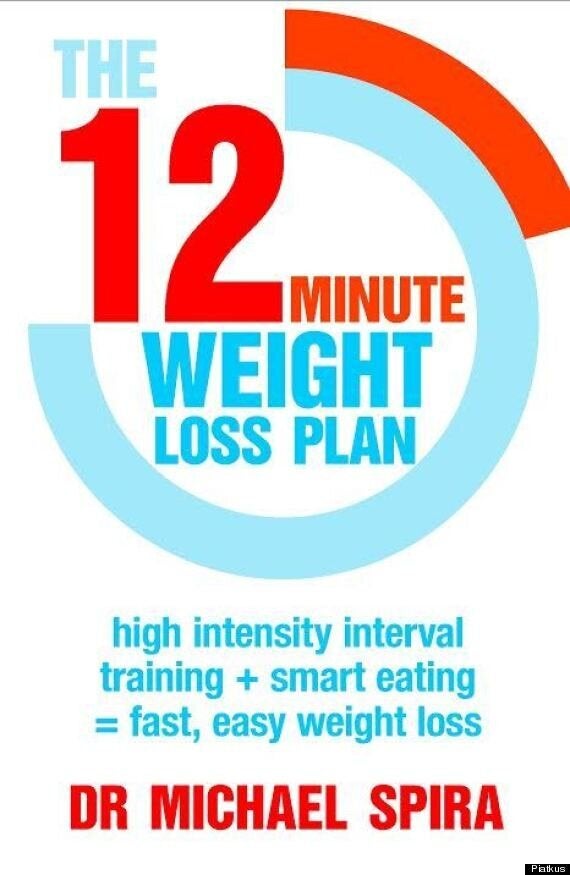With busy work schedules and packed social calendars, kickstarting weight-loss can be especially difficult this time of year.
But in his new book The 12-Minute Weight-Loss Plan obesity expert Dr Michael Spira suggests an easy eating plan and exercise routine that takes just 12 minutes a week.

Why, you might ask, do we need yet another book on how to lose weight? The simple answer is that so far no one has got the answer completely right. So what’s been going wrong until now?
To answer that we need to look at two issues: diet and exercise.
We all know that to lose weight you have to combine these two, but there’s a right and a wrong way for each. Or, perhaps more accurately, there’s a more effective way and a less effective way for each.
The myth with diet is that all you have to do is to cut calories or cut fat (unless you’re an Atkins fan, in which case you increase your fat!). But, as this book will show you, this is not an effective dietary approach for weight loss.
Yes, of course, you have to cut calories in some way, but it’s how you do it that is crucial.
Compared to the large amounts of carbs that people generally eat today, this book will show you how to lower carbs gently, allowing you to follow a diet that is closer to the one that was eaten by most people 40 or 50 years ago when obesity was rare and people were much healthier.
The myth with exercise is that to lose weight you have to put in lots of hours, preferably at a gym or jogging outside in all weathers, or swimming the equivalent of the English Channel every week. Again, this is just not true.
I presume the reason you’re interested in my book is because of that ‘12 minutes a week’ in the title – it’s the most attractive part for most people, so I won’t go into the dietary approach here, as there’s lots about that in the book.
For now, I think it’s sufficient to say that the diet is simple and delicious and won’t leave you hungry. Let’s focus for a moment on the 12-minutes of exercise part.
What’s that all about?
The buzzword is HIIT – that stands for high-intensity interval training. Instead of spending hours each week running around a park or on a treadmill, you spend a few minutes doing really intensive exercise, and you do this three times a week.
What do I mean by intense though?
Imagine running for a bus. It’s vital you catch it. Perhaps it’s the last bus home. You run as fast as you can for 30 seconds or so and catch it before the doors close. You then spend the next 30 seconds panting your way to recovery.
Essentially, with HIIT, you go through the equivalent of this cycle four times – that’s four minutes. Do this three times a week and there’s your 12 minutes of high-intensity interval training.
Why does this time-saving way of exercise work?
The answer is, we don’t fully know.
HIIT has been around for a while, mostly used by athletes, but it’s only in the last few years that its value for everybody has been recognised.
The HIIT sessions in this book bring the technique bang up to date and will appeal to anyone who wants to get fit and healthy, regardless of their age.
At least part of the reason why we become fat – and certainly a lot of the reason why we can’t shift that fat – is to do with inflammation in our body, especially a part of our brain called the hypothalamus.
Why it becomes inflamed is another story, but it has a lot to do with the kind of food we eat.
The key is that if we can reduce the inflammation we can increase the sensitivity of the hypothalamus to a hormone called leptin. This is made by fat tissue and acts on the brain to regulate our food intake and body weight.
The more sensitive our brain is to leptin, the easier it is to lose and control weight. And it seems that exercise, especially HIIT, reduces inflammation and improves leptin sensitivity.
That’s not the whole story, however. Another important factor in weight control is the burning of sugar in our bodies.
Sugar is stored as glycogen in our muscles. Conventional exercise, such as jogging, uses around 40% of the muscles in our body.
HIIT, on the other hand, can use as much as 80% of our body’s muscles. This means that HIIT can result in twice as much sugar being burned off.
A great bonus of HIIT is that its fat-burning effectiveness continues long after you’ve finished the exercise. That’s why I recommend HIIT three times a week on alternate days rather than every day.
Another bonus for this kind of exercise is that HIIT is a great way to improve your fitness.
As I hope you’ll find, the message of this book is simple: it isn’t necessary to ‘go on a diet’ in order to lose weight.
In fact, it’s positively counter-productive to do so. Nor is it necessary to spend hours in a gym working out.
The key to successful and permanent weight loss is a combination of lifestyle, properly focused very-short-duration exercise, and a few very small, subtle changes to your diet.
Extract from The 12-Minute Weight Loss Plan by Dr Michael Spira, published on 8th January 2015 by Piatkus, £12.99.

